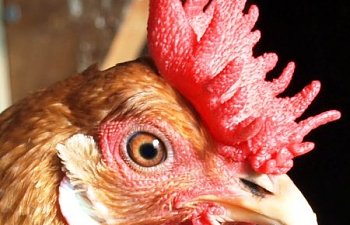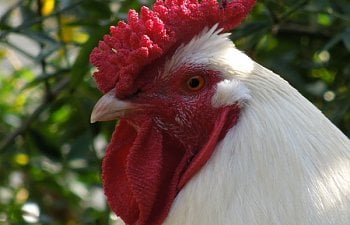Caruncles, Combs and Wattles
The Features, Functions and Healthcare
A caruncle is “a naked, fleshy outgrowth,” according to Meriam Webster’s Dictionary. It generally refers to the protuberances found on the head and neck including the combs, earlobes, snoobs and wattles. Their purposes vary, but include controlling the body temperature to aiding in mating.The Features, Functions and Healthcare
The color of the combs and wattles does not necessarily indicate the health of your poultry. The brilliance of their colors will be affected by various factors including breed, diet, their mating status and temperatures. Ayam Cemani and Silkies, for instance, have black combs. A rooster’s comb will typical swell slightly and become a more brilliant color during mating, in an attempt to attract the hens. Warmer temperatures may also cause a brilliant coloring due to the extra blood flowing through the caruncles in an attempt to cool the birds. Additionally, as shown in the photo of the Silkie below, the combs and wattles can have multiple colors. This does not indicate a health concern.
| Courtesy Of: LCahill Ayam Cemani | Courtesy Of: Mama Hen Chris Cecil, Silkie |
The fleshy growth or crest atop various birds’ heads is known is the comb. These are mostly commonly known in chickens, turkeys and pheasants. There are currently 9 recognized combs: buttercup, cushion, pea, rose, single, strawberry, Silkie, V and walnut combs.
The comb serves several functions. The primary function of the comb it to aid in the cooling of the birds. This is done through vascular blood flow in both the combs and wattles. Depending on the local climate, the comb can be vital to their survival or it can be the key to their untimely death.
Buttercup Comb
Breeds: Sicilian Buttercup The buttercup comb is a bowl shaped crown that sits atop the center of the skull. The deep recess in the center is completely surrounded by points or serrations, with a single lead in the front above the beak. There is a fine texture on the comb. The only breed known to have the buttercup comb is the Sicilian Buttercup, making it increasingly rare. They were imported from the Island of Sicily as hatching eggs during the 19th Century and was accepted in to the American Poultry Association’s Standards of Perfection in 1918. |
Cushion Comb
Pea Comb
Rose Comb
Single Comb
Strawberry Comb * Pending Approval from Owner for Photo
Breeds: Malay The strawberry comb is similar in style to the pea comb and cushion comb; however, it is distinct in its own category. The strawberry comb sits significantly forward of the skull, protruding over the top of the beak. Additionally, it is wider than both the cushion and pea combs. The texture of this comb resembles the hull of a strawberry, where the largest end covers the beak. |
V Comb * Pending Approval from Owner for Photo
Breeds: Appenzeller, Crevecoeur, Houdan, La Fleche, Polish, and Sultan |
Walnut Comb
Breeds: Orloff, Silkie, Yokohama |
Dubbing is the process of cutting the comb off of a chicken, while cropping is the removal of the wattles. There are two primary reasons that you would dub or crop one: preventing frostbite and showing a bird. Frostbite will be covered in a later section.
According to current standards, Modern or Old English Game cockerels must be dubbed and cropped within their first year after hatch in order to qualify for the shows. Under certain conditions, the earlobes may also be trimmed.
According to Randy Stevens, of Backyard Poultry Magazine, dubbing should be done once the cockerel has reached breeding age, approximately six to eight months old. To keep bleeding to a minimum, he recommends that the procedure be completed during the evening and in the last three days of the lunar cycle, just prior to the new moon. Ideally, it is also a good idea to avoid doing this during hot periods, where the blood has thinned and is flowing well through the comb in an effort to cool the cockerel.
Before Dubbing | After Dubbing | |
Courtesy Of: 420Rooster American Game Cockerel |
There is an assortment of problems can affect the combs and wattles of poultry. In general, one of three things occurs: avian pox, frostbite or pecking injuries. All three are handled fairly easily and don’t require a lot of effort to resolve.
Avian Pox
This disease is a relatively slow spreading avipoxvirus that occurs in birds. There are three known types of the virus: canary pox, fowl pox and pigeon pox. It is seen in two forms, either cutaneous (dry) or diphtheritic (wet). The cutaneous form is indicated by the formation of small lesions on the unfeathered parts of the body, usually the combs and wattles. Initially, these lesions are small pink or white blisters that contain pockets of the virus, as seen on the comb and earlobes of the chicken to the right. As it multiples, the lesions will grow and ultimately burst, spreading the virus to the contaminated areas. When these nodules progress, the will slowly turn to a brown or black coloring, seen in the blade of this chicken’s comb. The diphtheritic form affects the lungs, mouth, throat and trachea. Small yellow or white, moist necrotic areas develop and often restricts breathing, resulting in death by suffocation. Avian pox can be prevented by administering a vaccination developed from a modified live virus, commonly available from local feed shops or aviary veterinarians. Treatment of infected birds can be accomplished by removing the lesions and ensuring the wounds are treated to prevent infection. Iodine washes are the most common form of topical treatment. Additional information can be found from the Michigan Department of Natural Health. | Courtesy Of: HaysHays97 |
In cold, wet and windy regions, you are bound to find a chicken with frostbite on their caruncles and feet at some point. It is important to understand the causes and treatments. It occurs when temperatures are extremely low, generally in the sub-freezing range. However, they can also occur when the correct combination of high winds, low temperatures and/or wet conditions exist. It is important to have a dry coop and proper draft control during winter for this very reason. There must be proper ventilation, however, or the environment will host a variety of parasites.
Frostbite usually affects the combs and wattles of poultry first; however, the toes are also very susceptible to this injury. Moist, cold ground exacerbates the situation. As seen in the photo above, when frostbite occurs, the tips of the affected part turns black and dies. Eventually, the damaged part will usually fall off. Unless an infection is setting in, however, do not trim the dead area. It may be providing protection for the remaining sections of the comb or wattles.



